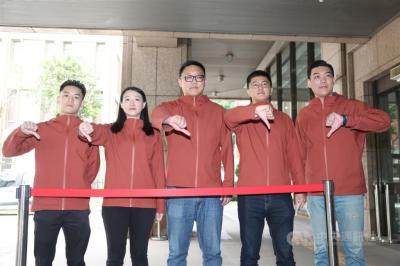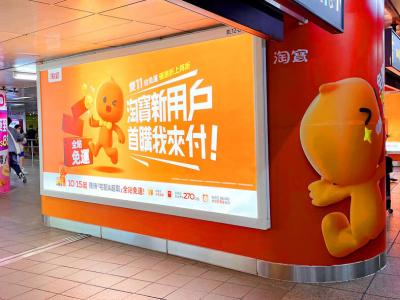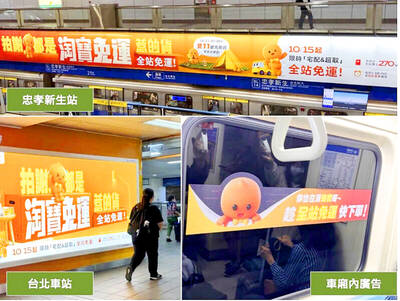The New Power Party (NPP) is the only “third force” party likely to be awarded at-large legislative seats, according to a new poll released yesterday by the Taiwan Thinktank, which also showed that a large majority of the party’s supporters come from the “pan-green” camp.
The poll results show that the NPP has a support rating of 5.6 percent for voters’ at-large legislative seat ballot, compared with 4.3 percent for the People First Party (PFP), 3.7 percent for the Taiwan Solidarity Union (TSU), 2.3 percent for the Green Party-Social Democratic Party Alliance (Green Party-SDP Alliance), 1.6 percent for the Free Taiwan Party and 0.7 percent for the Republic Party (Minkuotang, MKT).
The results, polled from an effective sample of 1,068 people, with a margin of error of 3 percentage points, suggest that among the smaller parties, only the NPP could reach the five percentage point vote threshold necessary to be awarded at-large legislative seats, while other parties couldmeet the 3.5 percent threshold to be eligible for political party subsidies.
Trend Survey and Research Co chief executive officer Chou Yung-hong (周永鴻) said that the Jan. 16 legislative elections were likely to lead to a “reshuffling” of small parties, with the TSU facing “extinction” amid the rise of “third force” parties associated with social movements, which have drawn support away from the TSU and the Democratic Progressive Party (DPP).
“Supporters of [DPP presidential candidate] Tsai Ing-wen (蔡英文), and the NPP and SDP basically overlap,” Chou said, citing the closely matching percentages of young, educated voters, who form the core of Tsai’s and “third force” party voters.
“The vast majority of NPP voters support Tsai, but some of Tsai’s voters are not turning around and supporting DPP legislative candidates,” he said, adding that the poll showed the NPP’s support was not confined to northern Taiwan and urban areas, where most of its district candidates have been fielded.
“Even though there is some competition with DPP legislative district candidates, the NPP firmly supports Tsai because it knows that many of its supporters are also Tsai’s supporters,” said Hsu Yung-ming (徐永明), a Soochow University political scientist who also serves on the NPP’s executive committee.
Poll results showed that the NPP strategy was correct, he said.
Attempts to integrate the NPP and SDP reportedly failed over the issue of whether a proposed alliance would support Tsai, with the SDP insisting on maintaining neutrality.
Steve Wang (王思為), an assistant professor in the Institute of European Studies at Nanhua University, said the poll suggest the need for the NPP and the Green Party-SDP Alliance to make electoral strategy adjustments, presenting themselves as more “green” to attract more votes from DPP and TSU supporters.
He said the alliance’s electoral focus on environmental and social justice issues failed to address voters’ concerns.

Taiwan is stepping up plans to create self-sufficient supply chains for combat drones and increase foreign orders from the US to counter China’s numerical superiority, a defense official said on Saturday. Commenting on condition of anonymity, the official said the nation’s armed forces are in agreement with US Admiral Samuel Paparo’s assessment that Taiwan’s military must be prepared to turn the nation’s waters into a “hellscape” for the Chinese People’s Liberation Army (PLA). Paparo, the commander of the US Indo-Pacific Command, reiterated the concept during a Congressional hearing in Washington on Wednesday. He first coined the term in a security conference last

Prosecutors today declined to say who was questioned regarding alleged forgery on petitions to recall Democratic Progressive Party (DPP) legislators, after Chinese-language media earlier reported that members of the Chinese Nationalist Party (KMT) Youth League were brought in for questioning. The Ministry of Justice Investigation Bureau confirmed that two people had been questioned, but did not disclose any further information about the ongoing investigation. KMT Youth League members Lee Hsiao-liang (李孝亮) and Liu Szu-yin (劉思吟) — who are leading the effort to recall DPP caucus chief executive Rosalia Wu (吳思瑤) and Legislator Wu Pei-yi (吳沛憶) — both posted on Facebook saying: “I

The Ministry of Economic Affairs has fined Taobao NT$1.2 million (US$36,912) for advertisements that exceed its approved business scope, requiring the Chinese e-commerce platform to make corrections in the first half of this year or its license may be revoked. Lawmakers have called for stricter enforcement of Chinese e-commerce platforms and measures to prevent China from laundering its goods through Taiwan in response to US President Donald Trump’s heavy tariffs on China. The Legislative Yuan’s Finance Committee met today to discuss policies to prevent China from dumping goods in Taiwan, inviting government agencies to report. Democratic Progressive Party Legislator Kuo Kuo-wen (郭國文) said

The Ministry of Economic Affairs has fined Taobao NT$1.2 million (US$36,900) for advertisements that exceeded its approved business scope and ordered the Chinese e-commerce platform to make corrections in the first half of this year or its license would be revoked. Lawmakers have called for stricter supervision of Chinese e-commerce platforms and more stringent measures to prevent China from laundering its goods through Taiwan as US President Donald Trump’s administration cracks down on origin laundering. The legislature’s Finance Committee yesterday met to discuss policies to prevent China from dumping goods in Taiwan, inviting government agencies to report on the matter. Democratic Progressive Party